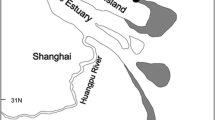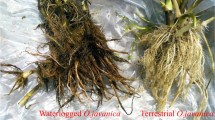Abstract
Synchrotron X-ray microfluorescence and X-ray absorption near-edge microstructure spectroscopy techniques were applied to Typha latifolia (cattail) root sections and rhizosphere soils collected from a brownfield site in New Jersey to investigate lead (Pb) accumulation in T. latifolia roots and the role of iron (Fe) plaque in controlling Pb uptake. We found that Pb and Fe spatial distribution patterns in the root tissues are similar with both metals present at high concentrations mainly in the epidermis and at low concentrations in the vascular tissue (xylem and phloem), and the major Pb and Fe species in T. latifolia root are Pb(II) and Fe(III) regardless of concentration levels. The sequestration of Pb by T. latifolia roots suggests a potential low-cost remediation method (phytostabilization) to manage Pb-contaminated sediments for brownfield remediation while performing wetland rehabilitation.





Similar content being viewed by others
Reference
Ablett JM, Kao CC, Reeder RJ, Tang Y, Lanzirotti A (2006) X27A—a new hard X-ray micro-spectroscopy facility at the National Synchrotron Light Source. Nucl Instrum Methods Phys Res, Sect A 562:487–494
Bacha RE, Hossner LR (1977) Characteristics of coatings formed on rice roots as affected by iron and manganese additions. Soil Sci Soc Am J 41:931–935
Bargar JR, Brown GE, Parks GA (1997) Surface complexation of Pb(II) at oxide-water interface: II. XAFS and bond-valence determination of mononuclear Pb(II) sorptionproducts and surface functional groups on iron oxides. Geochim Cosmochim Acta 61:2639–2652
Bartlett RJ (1961) Iron oxidation proximate to plant roots. Soil Sci 92:372–379
Batty LC (2003) Wetland plants—more than just a pretty face? Land Contam Reclam 11:173–180
Chen CC, Dixon JB, Turner FT (1980) Iron coatings on rice roots: mineralogy and quantity influencing factors. Soil Sci Soc Am J 44:635–639
Eick MJ, Peak JE, Brady PV, Pesek JD (1999) Kinetics of lead adsorption and desorption on goethite: residence time effect. Soil Sci 164:28–39
Emerson D, Weiss JV, Megonigal JP (1999) Iron-oxidizing bacteria are associated with ferric hydroxide precipitates (Fe-plaque) on the roots of wetland plants. Appl Environ Microbiol 65:2758–2761
Enstone DE, Peterson CA, Ma F (2003) Root endodermis and exodermis: structure, function, and responses to the environment. J Plant Growth Regul 21:335–351
Feng H, Cochran JK, Lwiza H, Brownawell B, Hirschberg DJ (1998) Distribution of heavy metal and PCB contaminants in the sediments of an urban estuary: the Hudson River. Mar Environ Res 45:69–88
Feng H, Han X, Zhang W, Yu L (2004) A preliminary study of heavy metal contamination in Yangtze River intertidal zone due to urbanization. Mar Pollut Bull 49:910–915
Frenzel P, Bosse U, Janssen PH (1999) Rice roots and methanogenesis in a paddy soil: ferric iron as an alternative electron acceptor in the rooted soil. Soil Biol Biochem 31:421–430
Gallagher FJ, Pechmann I, Bogden JD, Grabosky J, Weis P (2008) Soil metal concentrations and vegetative assemblage structure in an urban brownfield. Environ Pollut 153:351–361
Gilbert B, Frenzel P (1998) Rice roots and CH4 oxidation: the activity of bacteria, their distribution and the microenvironment. Soil Biol Biochem 30:1903–1916
Hansel CM, Fendorf S, Sutton S, Newville M (2001) Characterization of Fe plaque and associated metals on the roots of mine-waste impacted aquatic plants. Environ Sci Technol 35:3863–3868
Hansel CM, Laforce MJ, Fendorf S, Sutton S (2002) Spatial and temporal association of As and Fe species on aquatic plant roots. Environ Sci Technol 36:1988–1994
Hinsinger P, Courchesne F (2008) Biogeochemistry of metals and metalloids at the soil–root interface. In: Violante A, Huang PM, Gadd GM (eds) Biophysico-chemical processes of heavy metals and metalloids in soil environments. Wiley, Hoboken, pp 267–311
King GM, Garey MA (1999) Ferric iron reduction by bacteria associated with the roots of freshwater and marine macrophytes. Appl Environ Microbiol 65:4393–4398
Koelmel J, Amarasiriwardena D (2012) Imaging of metal bioaccumulation in Hay-scented fern (Dennstaedtia punctilobula) rhizomes growing on contaminated soils by laser ablation ICP-MS. Environ Pollut 168:62–70
Lacerda LD, Freixo JL, Coelho SM (1997) The effect of Spartina alterniflora Loisel on trace metals accumulation in inter-tidal sediments. Mangrove Salt Marshes 1:201–209
Liu WJ, Zhu YG, Smith FA, Smith SE (2004) Do iron plaque and genotypes affect arsenate uptake and translocation by rice seedlings (Oryza sativa L.) grown in solution culture? J Exp Bot 55:1707–1713
Loring DH (1991) Normalization of heavy-metal data from estuarine and coastal sediments. ICES J Mar Sci 48:101–115
Manceau A, Boisset MC, Sarret G, Hazemann JL, Mench M, Cambier P, Prost R (1996) Direct determination of lead speciation in contaminated soils by EXAFS spectroscopy. Environ Sci Technol 30:1540–1552
Martin RR, Naftel SJ, Skinner W, Jones KW, Feng H (2003) Micro-synchrotron x-ray fluorescence of the metal distribution in a black spruce tree stem: evidence from radial mobility. X-Ray Spectrom 32:402–407
Martin R, Naftel S, Macfie S, Jones K, Feng H, Trembley C (2006) High variability of the metal content of tree growth rings as measured by synchrotron micro x-ray fluorescence spectrometry. X-Ray Spectrom 35:57–62
McLaughlin MJ, Smolders E, Merckx R (1998) Soil–root interface: physicochemical processes. In: Huang PM, Adriano DC, Logan TJ, Checkai RT (eds) Soil chemistry and ecosystem health. Soil Science Society of America, Madison, pp 233–277
Mendelssohn IA, Postek MT (1982) Elemental analysis of deposits on the roots of Spartina alterniflora Loisel. Am J Bot 69:904–912
Naftel SJ, Martin RR, Courchesne F, Séguin V, Protz R (2002) Studies of the effects of soil biota on metal bioavailability. Can J Anal Sci Spectros 47:36–40
Newville M (2004) Fundamentals of XAFS. Consortium for Advanced Radiation Sources, University of Chicago, Chicago, IL. Revision 1.7. pp. 41
Onwueme V, Feng H (2006) Risk characterization of contaminants in Passaic River sediments, New Jersey. Middle States Geogr 39:13–25
Ostergren JD, Brown GE Jr, Parks GA, Tingle TN (1999) Quantitative speciation of lead in selected mine tailings from Leadville, CO. Environ Sci Technol 33:1627–1636
Otte ML, Rozema J, Koster L, Haarsma MS, Broekman RA (1989) Iron plaque on roots of Aster tripolium L.: interaction with zinc uptake. New Phytol 111:309–317
Otte ML, Dekkers MJ, Rozema J, Broekman RA (1991) Uptake of arsenic by Aster tripolium in relation to rhizosphere oxidation. Can J Bot 69:2670–2677
Perret D, Gaillard J, Dominik J, Atteia O (2000) The diversity of natural hydrous iron oxides. Environ Sci Technol 34:3540–3546
Qian Y, Gallagher FJ, Feng H, Wu M (2012) A geochemical study of toxic metal translocation in an urban brownfield wetland. Environ Pollut 166:23–30
Rotkittikhum P, Kruatrachue M, Chaiyarat R, Ngernsansaruay C, Pokethitiyook P, Paijitprapaporn A, Baker AJM (2006) Uptake and accumulation of lead by plants from the Bo Ngam lead mine area in Thailand. Environ Pollut 144:681–688
Sarkar D, Datta R, Sharma S (2009) Fate and bioavailability of arsenic in organo-arsenical pesticide-applied soils: part-I: incubation study. Chemosphere 60:188–195
St-Cyr L, Campbell PGC (1996) Metals (Fe, Mn, Zn) in the root plaque of submerged aquatic plants collected in situ: relations with metal concentrations in the adjacent sediments and in the root tissue. Biogeochemistry 33:45–76
St-Cyr L, Crowder AA (1990) Manganese and copper in the root plaque of Phragmites australis (Cav.) Trin. ex Steudel. Soil Sci 149:191–198
Sundby B, Vale C, Caçador I, Catarino F, Madureira MJ, Caetano M (1998) Metal-rich concretions on the roots of salt marsh plants: mechanism and rate of formation. Limnol Oceanogr 43:245–252
Tangahu BV, Abdullah SRS, Basri H, Idris M, Anuar N, Mukhlisin M (2011) A review on heavy metals (As, Pb, and Hg) uptake by plants through phytoremediation. Int J Chem Eng. doi:10.1155/2011/939161
Taylor GJ (1987) Exclusion of metals from the symplasm: a possible mechanism of metal tolerance in higher plants. J Plant Nutr 10:1213–1222
Taylor SR, McLennan SM (1995) The geochemical evolution of the continental crust. Rev Geophys 33:241–265
Taylor GJ, Crowder AA, Rodden R (1984) Formation and morphology of an iron plaque on the roots of Typha latifolia L. grown in solution culture. Am J Bot 71:666–675
Templeton AS, Ostergren JD, Trainor TP, Foster AL, Traina SJ, Spormann A, Brown GE Jr (1999) XAFS and XSW studies of the distribution and chemical speciation of Pb sorbed to biofilms on α-Al2O3 and α-FeOOH surfaces. J Synchrotron Radiat 6:642–644
USACE (United States Army Corps of Engineers) (2005) Hudson-Raritan Estuary Environmental Restoration Study. Environmental Resource Inventory, Liberty State Park, p 190, Technical Report
Wang TG, Peverly JH (1999) Iron oxidation states on root surfaces of a wetland plant (Phragmites australis). Soil Sci Soc Am J 63:247–252
Weis JS, Weis P (2004) Metal uptake, transport and release by wetland plants: implications for phytoremediation and restoration. Environ Int 30:685–700
Williams TP, Bubb JM, Lester JN (1994) Metal accumulation within salt marsh environments: a review. Mar Pollut Bull 28:273–290
Ye ZH, Baker AJM, Wong MH, Willis AJ (1998) Zinc, lead and cadmium accumulation and tolerance in Typha latifolia as affected by iron plaque on the root surface. Aquat Bot 61:55–67
Zhang W, Yu L, Hutchinson SM (2001) Diagenesis of magnetic minerals in the intertidal sediments of the Yangtze Estuary, China and its environmental significance. Sci Total Environ 266:169–175
Zhang W, Feng H, Chang J, Qu J, Xie H, Yu L (2009) Heavy metal contamination in surface sediments of Yangtze River intertidal zone: an assessment from different indexes. Environ Pollut 157:1533–1543
Acknowledgments
This work was supported in part by the Margaret and Herman Sokol Foundation (H.F.), China Scholarship Council (Y.Q.), and Montclair State University Separate Budget Award. Portions of this work were performed at Beamline X27A, National Synchrotron Light Source (NSLS), Brookhaven National Laboratory. X27A is supported in part by the U.S. Department of Energy–Geosciences (DE-FG02-92ER14244 to The University of Chicago–CARS). Use of the NSLS was supported by the U.S. Department of Energy, Office of Science, Office of Basic Energy Sciences, under contract no. DE-AC02-98CH10886. The part of work in Biology Department, Brookhaven National Laboratory (K.Z and C.J.L.) was supported in part by National Science Foundation through grant MCB-1051675 to C.J.L. We are grateful to Professor Elena Maestri, Editor of Environmental Science and Pollution Research, and two anonymous reviewers who offered constructive comments and suggestions on an earlier draft of this paper. The authors also wish to thank Christina Soman and Jikai Xu of Montclair State University for their assistance in the field work.
Author information
Authors and Affiliations
Corresponding author
Additional information
Responsible editor: Elena Maestri
Rights and permissions
About this article
Cite this article
Feng, H., Qian, Y., Gallagher, F.J. et al. Lead accumulation and association with Fe on Typha latifolia root from an urban brownfield site. Environ Sci Pollut Res 20, 3743–3750 (2013). https://doi.org/10.1007/s11356-012-1298-x
Received:
Accepted:
Published:
Issue Date:
DOI: https://doi.org/10.1007/s11356-012-1298-x




